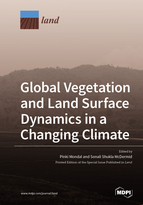Global Vegetation and Land Surface Dynamics in a Changing Climate
A special issue of Land (ISSN 2073-445X).
Deadline for manuscript submissions: closed (30 November 2019) | Viewed by 30514
Special Issue Editors
Interests: impacts of climate variability and change on ecosystems; land-cover land-use change; remote sensing; GIS
Special Issue Information
Dear Colleagues,
Changes in vegetation biomass have multiple drivers, including natural ecosystem variability, climate changes, and anthropogenic activities. Historically, clearing of native ecosystems for agriculture has dominated vegetation transitions, but there is growing evidence of ecosystem change in response to altered rainfall and climate regimes, seasonality, CO2 fertilization effects, and infrastructure development related to urbanization. Many ecosystems and environments around the globe are currently also “coupled natural–human systems”, displaying responses to both biophysical and socio-economic drivers simultaneously. Future climate changes and intensifying land management will bring additional, interactive changes to natural and managed ecosystems. Managing these systems requires improved understanding of the multi-scale drivers of regional and global vegetation dynamics, the mechanisms by which they operate, and how they have and will change over time and under various scenarios of future change.
Land announces a Special Issue dedicated to studies from diverse perspectives, including observed, empirical, and process-based modeling approaches. Research papers are expected to examine vegetation trends and identify the critical scales, mechanisms, and feedbacks driving vegetation and land surface dynamics in a changing climate. The Special Issue will emphasize emerging trends, vegetation responses to ecosystem change, and outstanding uncertainties to direct future data collection efforts and model development.
High-quality contributions covering the topic areas listed below are solicited for the Special Issue:
- Remotely sensed indicators (derived from multi-scale satellite data and/or UAV) for elucidating vegetation dynamics in natural or managed landscapes
- Methods using modeling tools (using dynamic ecosystem models, Earth System Models, global climate models, etc.) to understand ecosystem dynamics and responses to climate forcings and global environmental change
- Interactions between human and natural ecosystems in a changing climate
- Regionally-focused assessments of ecosystem functionality, “health” (e.g., resilience), and their teleconnections and remote effects
Dr. Sonali Shukla McDermid
Guest Editors
Manuscript Submission Information
Manuscripts should be submitted online at www.mdpi.com by registering and logging in to this website. Once you are registered, click here to go to the submission form. Manuscripts can be submitted until the deadline. All submissions that pass pre-check are peer-reviewed. Accepted papers will be published continuously in the journal (as soon as accepted) and will be listed together on the special issue website. Research articles, review articles as well as short communications are invited. For planned papers, a title and short abstract (about 100 words) can be sent to the Editorial Office for announcement on this website.
Submitted manuscripts should not have been published previously, nor be under consideration for publication elsewhere (except conference proceedings papers). All manuscripts are thoroughly refereed through a single-blind peer-review process. A guide for authors and other relevant information for submission of manuscripts is available on the Instructions for Authors page. Land is an international peer-reviewed open access monthly journal published by MDPI.
Please visit the Instructions for Authors page before submitting a manuscript. The Article Processing Charge (APC) for publication in this open access journal is 2600 CHF (Swiss Francs). Submitted papers should be well formatted and use good English. Authors may use MDPI's English editing service prior to publication or during author revisions.
Keywords
- vegetation-climate interactions
- human-environment interactions
- ecosystem dynamics
- vegetation health
- climate forcings
- teleconnections
- remote sensing
- process-based models







